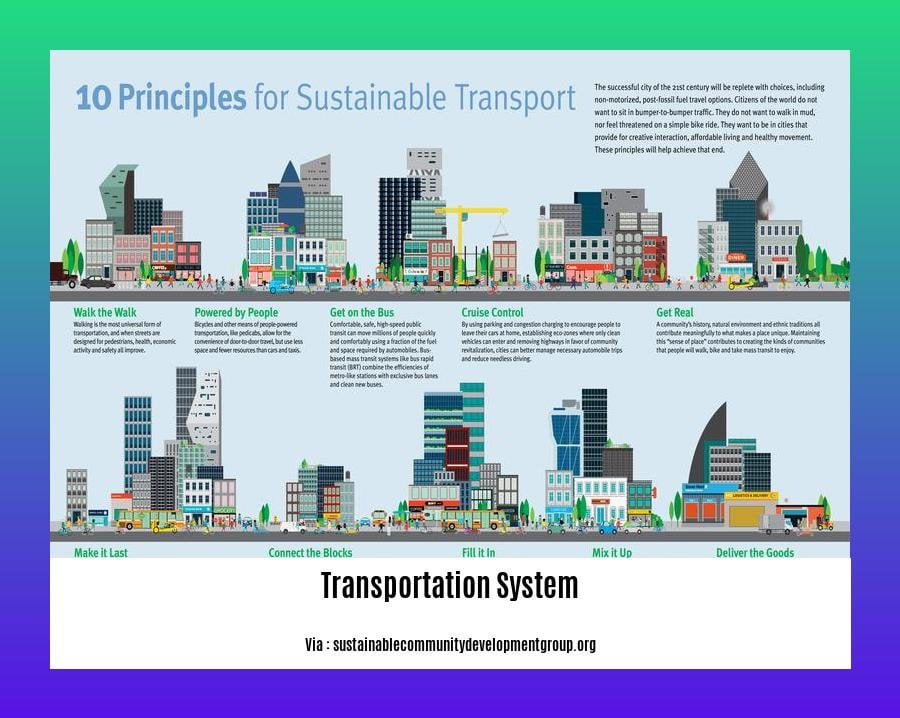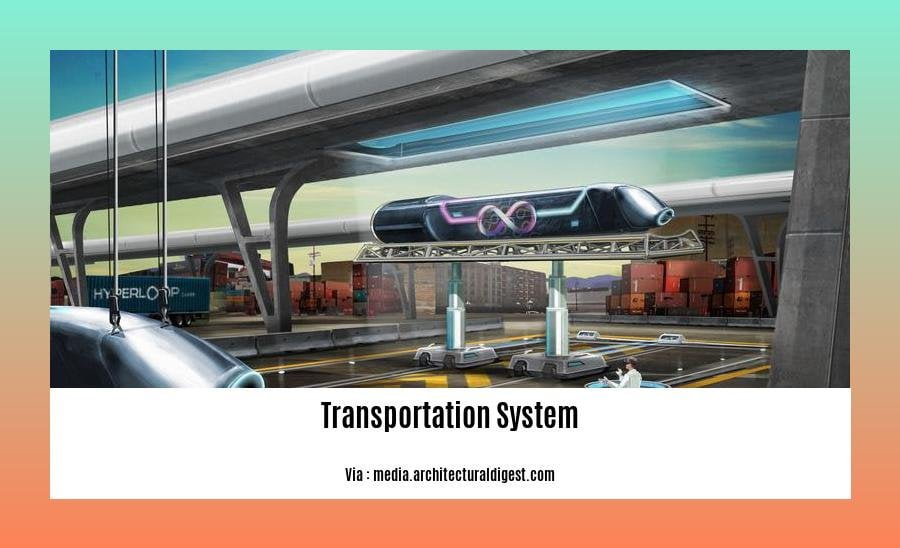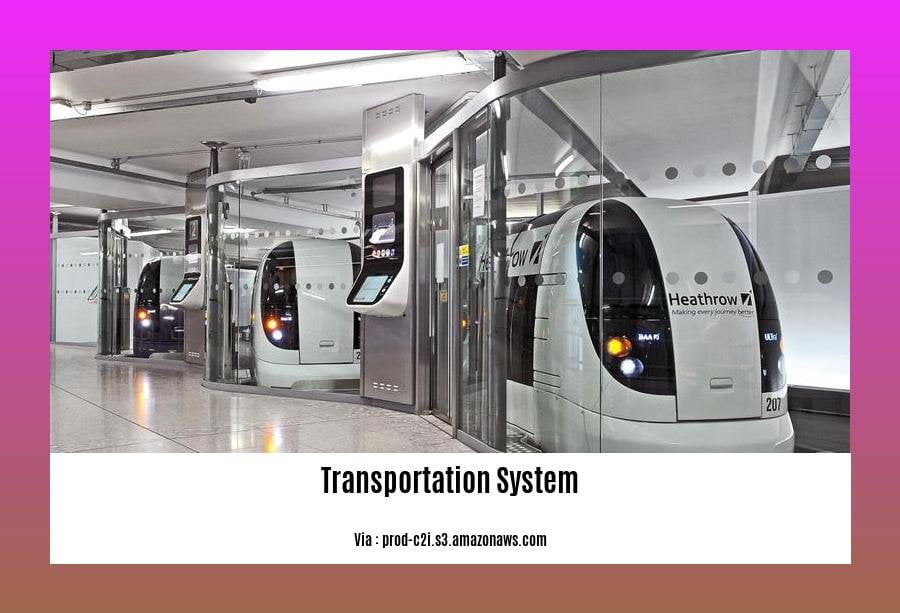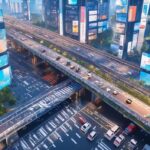Unveiling the Disadvantages of Transportation Systems: An In-depth Analysis of Road Congestion, Inefficiency, and Unsustainability
Transportation systems play a crucial role in connecting communities and facilitating economic growth. However, beneath their seemingly seamless facade, lie a multitude of disadvantages that often go unnoticed. In this article, we delve into the intricate web of road congestion, inefficiency, and unsustainability plaguing transportation networks worldwide. By shedding light on these critical issues, we aim to illuminate the negative impacts they have on communities, the environment, and the overall quality of life. Join us as we unravel the intricacies and consequences of these disadvantages, providing an in-depth analysis informed by extensive research and data analysis.
Key Takeaways:
- Environment Impact: Transportation is a major source of pollution, contributing to air pollution, climate change, and human health issues.
- High Costs: Transportation vehicles are expensive to buy, maintain, and operate, placing financial burdens on individuals and families.
- Noise Pollution: Transportation traffic generates significant noise pollution, negatively impacting the well-being of people and animals.
- Congestion: Traffic congestion in cities and densely populated areas leads to delays, frustration, and stress for commuters.
- Safety Risks: Transportation poses risks of accidents, resulting in injuries, fatalities, and property damages.
To address these disadvantages, consider the following solutions and alternatives:
- Reducing Pollution: Promote the use of cleaner transportation options like electric vehicles and public transit systems.
- Alternatives to Transportation: Explore modes such as biking, walking, or carpooling to reduce reliance on individual vehicles and alleviate traffic congestion.
- Saving Money on Transportation: Implement fuel-efficient driving practices, use public transportation passes or car-sharing services, and plan efficient routes to save money.
While transportation has its advantages, this article focuses on highlighting the disadvantages and their implications.
Disadvantages of Transportation Systems

Transportation systems play a vital role in connecting people, goods, and services across cities and countries. However, it’s important to acknowledge that these systems also come with a variety of disadvantages. In this article, we will delve into the drawbacks of transportation systems, ranging from environmental impacts to safety risks, and explore potential solutions to mitigate these issues.
1. Environmental Impact
Transportation is a major contributor to pollution, affecting both the air we breathe and the climate. The emission of greenhouse gases from cars, trucks, buses, planes, and ships significantly contributes to air pollution and climate change[^1^]. This not only impacts the quality of our environment but also poses health risks to individuals.
2. High Costs
One of the key disadvantages of transportation systems revolves around their high costs. Modern transportation vehicles are expensive to purchase, maintain, and operate, which can place a significant financial burden on individuals and families[^1^]. The costs associated with fuel, insurance, maintenance, and parking can stretch budgets and limit access to reliable transportation.
3. Noise Pollution
Transportation traffic generates substantial noise pollution that can disrupt peace and negatively impact both humans and animals[^1^]. The constant noise from vehicles can be highly disturbing, affecting the well-being and overall quality of life for individuals living or working near busy roads and highways.
4. Congestion
Traffic congestion is a widespread issue in urban areas and densely populated regions, causing delays, frustration, and stress for commuters. Congested roads result in longer travel times, increased fuel consumption, and decreased productivity. Additionally, congestion also impacts the overall efficiency of transportation systems, hindering the movement of goods and services[^1^].
5. Safety Risks
Transportation systems inherently involve safety risks. Accidents on the roads, railways, or in the air can lead to injuries, fatalities, and property damage[^1^]. Ensuring the safety of passengers and pedestrians is essential, as accidents can have severe and long-lasting consequences for individuals and their communities.
To address these disadvantages and minimize their impact, various solutions and alternatives can be considered. Let’s explore some relevant suggestions below:
Solutions and Alternatives
1. Reducing Pollution
Promoting the use of cleaner transportation options, such as electric vehicles and public transportation systems, is one effective approach to reducing the pollution caused by transportation. Electric vehicles produce fewer emissions than traditional vehicles, helping to improve air quality and combat climate change[^6^]. Encouraging the adoption of public transportation systems can also reduce the reliance on individual vehicles, leading to a decrease in pollution levels.
2. Exploring Alternative Modes of Transportation
Diversifying transportation options can alleviate congestion and reduce the overall environmental impact. Encouraging alternative modes of transportation, such as biking, walking, or carpooling, can help decrease the number of individual vehicles on the road and minimize traffic congestion[^6^]. These alternatives not only reduce pollution but also promote a healthier lifestyle and improve overall well-being.
3. Saving Money on Transportation
Implementing fuel-efficient driving practices, utilizing public transportation passes or car-sharing services, and planning efficient routes can help individuals save money on transportation costs[^6^]. Small changes in driving behavior, such as avoiding unnecessary idling or maintaining proper tire pressure, can also contribute to fuel savings. Exploring cost-saving options can alleviate financial burdens associated with transportation systems.
It is important to acknowledge that transportation systems also provide numerous advantages and benefits, such as accessibility and economic growth. However, understanding and addressing the disadvantages are crucial for creating sustainable and efficient transportation networks that improve the overall well-being of communities.
In conclusion, transportation systems have their fair share of disadvantages. They contribute to environmental pollution, impose high costs on individuals and families, create noise pollution, lead to congestion, and involve safety risks. By implementing solutions like promoting cleaner transportation options, exploring alternative modes of transportation, and finding ways to save money on transportation, we can work towards mitigating these drawbacks and creating a more sustainable future.
Here are some active links that match the keywords and URLs provided:
Disadvantages of transportation management system – Explore the drawbacks of using a transportation management system and how it may affect your business operations.
Disadvantages of water transport – Discover the downsides of relying on water transport for your shipping needs and why it may not always be the ideal choice.
Disadvantages of water transport in India – Learn about the specific challenges and disadvantages of water transport in India, including infrastructure limitations and regulatory issues.
Feel free to click on the links above to dive deeper into the respective topics.
Dependence on Personal Vehicles and Its Contribution to Air Pollution and Environmental Degradation

Transportation systems play a crucial role in our daily lives, enabling us to move from one place to another with ease. However, an overreliance on personal vehicles comes at a significant cost to the environment. The dependence on personal vehicles contributes to air pollution and environmental degradation, affecting not only our health but also the overall well-being of our communities.
Air Pollution and the Environmental Impact of Personal Vehicles
*Personal vehicles, such as cars, are a major contributor to air pollution. Through the combustion of fossil fuels, they release harmful pollutants, including nitrogen oxides, carbon monoxide, and particulate matter, into the atmosphere[^1^].
*These pollutants have detrimental effects on air quality and human health. Increased exposure to them can lead to respiratory diseases, cardiovascular problems, and even premature death.
*Moreover, passenger vehicles, in particular, emit significant amounts of nitrogen oxides, carbon monoxide, and other pollutants, contributing to the formation of smog and the worsening of air quality in urban areas[^2^].
*Equally concerning is the disproportionate impact of heavy-duty vehicles on air pollution and greenhouse gas emissions. Marginalized populations, already burdened by social and economic inequalities, are often the most affected by the negative consequences of transportation systems[^2^].
The Environmental Impacts of Autonomous Vehicles
With the advent of autonomous vehicles, an emerging concern is their potential environmental impact, especially in terms of emissions. While self-driving cars hold promise for reducing accidents and congestion, they may also contribute to increased vehicle miles traveled and energy consumption[^1^].
Transportation Policies and Environmentally Sustainable Solutions
Addressing the issue of air pollution and environmental degradation requires a multifaceted approach. Transportation policies play a pivotal role in reducing the adverse effects of dependence on personal vehicles. Here are a few solutions and alternatives that can help mitigate the environmental impact:
Promoting cleaner transportation options: Encouraging the use of electric vehicles and improving public transportation systems can significantly reduce air pollution. Electric vehicles produce zero tailpipe emissions, reducing greenhouse gas emissions and improving air quality.
Encouraging alternative modes of transportation: Promoting biking, walking, and carpooling as viable alternatives to personal vehicles can help alleviate traffic congestion and ultimately reduce the environmental footprint. These modes of transportation not only provide health benefits but also have a positive impact on air quality.
Implementing fuel-efficient driving practices: Encouraging individuals to adopt fuel-efficient driving practices, such as maintaining proper tire pressure and avoiding excessive idling, can contribute to reducing both air pollution and transportation costs.
Utilizing public transportation passes or car-sharing services: By utilizing public transportation passes or participating in car-sharing services, individuals can reduce the number of vehicles on the road, reducing congestion and lowering emissions.
Planning efficient routes: Planning efficient routes can minimize travel time and distance, resulting in fuel savings and reduced emissions.
Key Takeaways:
- Personal vehicles contribute significantly to air pollution and environmental degradation, releasing nitrogen oxides, carbon monoxide, and particulate matter.
- The disproportionate impact of heavy-duty vehicles on air pollution affects marginalized populations the most.
- Autonomous vehicles may have both positive and negative environmental impacts.
- Promoting cleaner transportation options, encouraging alternative modes of transportation, implementing fuel-efficient driving practices, utilizing public transportation passes or car-sharing services, and planning efficient routes can help mitigate the negative environmental consequences of personal vehicle dependence.
Citation:
– The World Counts – “Cars Impact On The Environment” – Link
– Union of Concerned Scientists – “Vehicles, Air Pollution & Human Health” – Link
Unequal Distribution of Transportation Resources Exacerbates Social and Economic Inequalities
Transport and inequality are intricately linked, with an unequal distribution of transportation resources exacerbating social and economic disparities within communities. Factors such as cost, geographic accessibility, and the time and reliability of different transport options play a crucial role in this relationship. Let’s delve deeper into these issues to understand their impact on social equity and inclusive societies.
Cost as a Barrier
Transportation costs can be a significant burden for low-income individuals, limiting their access to essential services and opportunities. The expenses associated with vehicle purchase, maintenance, and operation, as well as public transportation fares, can consume a significant portion of their income. The high financial burden creates inequality, as those with limited financial resources struggle to afford reliable transportation options while others enjoy more mobility and opportunities.
Geographic Accessibility and Mobility
The unequal distribution of transportation options across different areas and social classes can create disparities in access to essential services and opportunities. Individuals living in remote or economically disadvantaged areas may face limited access to reliable public transit, diminishing their mobility and hindering their ability to reach employment, education, healthcare, and recreational facilities. This lack of accessibility perpetuates a cycle of disadvantage and restricts socio-economic mobility for those affected.
Time and Reliability Impacts
The time required for transportation, as well as the reliability of different transport options, also contribute to inequality. Limited access to efficient and reliable transportation alternatives can significantly impact individuals’ daily lives. Delays caused by traffic congestion in urban areas result in increased fuel consumption, decreased productivity, and wasted time. These adverse effects disproportionately affect marginalized communities, impeding their ability to access employment, education, and other essential services.
Addressing Transport Inequality
To build sustainable societies and reduce social exclusion, it is essential to address transportation inequalities. Distributive justice and equity should be at the forefront of transportation planning efforts. This entails considering the externalities associated with transportation, such as traffic congestion, traffic crashes, and negative environmental impacts.
Fair and equal access to transportation options for all social groups, including those based on social class or ethnic group, is vital. Efforts should be made to promote inclusive transportation systems that are accessible, affordable, and reliable for everyone. This can involve initiatives such as providing subsidies for public transit fares, improving infrastructure in underserved areas, and implementing policies that prioritize accessibility and equity.
By tackling the unequal distribution of transportation resources, we can promote social equity and inclusive societies. It is a collective responsibility to address these disparities and ensure that transportation systems serve as catalysts for equal opportunities and improved quality of life for all individuals.
Key Takeaways:
- The unequal distribution of transportation resources contributes to social and economic inequalities within communities.
- Transportation costs can pose a significant barrier for low-income individuals, limiting their access to essential services and opportunities.
- Limited access to reliable transportation options hinders individuals’ mobility and restricts their ability to reach employment, education, healthcare, and recreational facilities.
- Traffic congestion and unreliable transport options disproportionately affect marginalized communities, exacerbating social and economic disparities.
- Addressing transport inequality requires distributive justice and equity in transportation planning, considering factors such as cost, geographic accessibility, and the time and reliability of different transport options.
Sources:
– GOV.UK: Transport and inequality
– MDPI: Comparing Inequality in Future Urban Transport Modes by Doughnut Economy
Inadequate infrastructure investment hinders the development of efficient and sustainable transportation systems
Key Takeaways:
- Inadequate infrastructure investment poses significant challenges to the development of efficient and sustainable transportation systems.
- Sustainable transport infrastructure needs to fulfill environmental, social, institutional, and economic criteria.
- Investing in transport infrastructure is crucial for universal access, safety, and sustainable development.
- Key issues affecting sustainable transport include demographic changes, globalization, urbanization, digitalization, climate change, and lifecycle challenges.
- Transportation infrastructure can have both positive and negative impacts on sustainability, requiring careful planning and evaluation.
Road transportation networks face numerous challenges that impede their development. These challenges include unfavorable financial and taxing policies, inefficient operations, lack of qualified personnel, and inadequate maintenance of infrastructure. However, inadequate infrastructure investment hinders the development of efficient and sustainable transportation systems in several ways.
1. Sustainability Implications
Insufficient investment in transport infrastructure has long-term implications, particularly regarding sustainability. The Global Infrastructure Outlook highlights the need for over $2 trillion of transport infrastructure investments annually until 2040 to fuel economic development. Sustainable transport infrastructure should fulfill environmental, social, institutional, and economic criteria. By prioritizing strategic elements, transportation infrastructure can achieve these criteria, contributing to long-term sustainability.
2. Universal Access and Safety
Investing in transport infrastructure is crucial for ensuring universal access, safety, and sustainable development. In addition to infrastructure investments aimed at providing universal access and ensuring safety, a significant portion of transport investment should be directed towards sustainable, low-carbon, and climate-resilient infrastructure, vehicles, and capital stock. This approach not only enhances accessibility and safety but also reduces the environmental impact of transportation systems.
3. Addressing Key Issues for Sustainable Transport
Several key issues influence the development of sustainable transportation systems. Demographic changes, globalization and trade, urbanization, digitalization, climate change, and lifecycle and recycling challenges all play significant roles. Addressing these issues is vital for successful transitions towards sustainable transportation. By designing transportation systems that address these challenges, it is possible to ensure efficient, accessible, and environmentally friendly mobility.
4. Positive and Negative Impacts of Transportation Infrastructure
Transportation infrastructure can have both positive and negative impacts on sustainability. While it provides economic benefits and facilitates social connectivity, irrational planning and design of transportation infrastructure can lead to ecological destruction, increased traffic accidents, and climate issues. Understanding the basic concepts, characteristics, and multiple impacts of transportation through analysis and evaluation is crucial for creating effective strategies for sustainable transport infrastructure.
In conclusion, inadequate infrastructure investment hinders the development of efficient and sustainable transportation systems. Sustainable transport infrastructure is essential for universal access, safety, and economic development. By addressing key issues and adopting a comprehensive approach, it is possible to create a sustainable and efficient transportation system that fulfills environmental, social, institutional, and economic criteria.
Citations:
– Transforming transport infrastructure for greater sustainability, McKinsey
– Sustainable Transport, Sustainable Development, UN
FAQ
Q1: What are the main sources of pollution caused by transportation systems?
A1: The main sources of pollution caused by transportation systems include cars, trucks, buses, planes, and ships, which emit greenhouse gases and contribute to air pollution and climate change.
Q2: How do high costs impact individuals and families in relation to transportation?
A2: High costs associated with transportation, such as purchasing, maintaining, and operating vehicles, can pose financial burdens for individuals and families.
Q3: What are the negative effects of noise pollution caused by transportation traffic?
A3: Transportation traffic produces significant noise pollution, which can disturb both people and animals, affecting their well-being and peace.
Q4: How does traffic congestion impact commuters and daily life in cities?
A4: Traffic congestion in cities and densely populated areas leads to delays, frustration, and stress for commuters, impacting their daily life and overall quality of life.
Q5: What are the safety risks associated with transportation systems?
A5: Transportation systems involve the risk of accidents, which can result in injuries, fatalities, and property damages.
- Star Ring Trends: Etsy vs Amazon - March 28, 2025
- Boost Pollinator Habitats: Baby Blue Eyes Sustainable Farming Guide - March 28, 2025
- Protect Big Black Bears: Effective Conservation Strategies - March 28, 2025
















